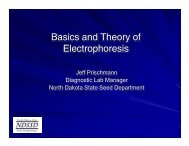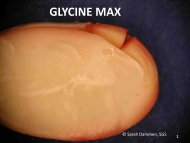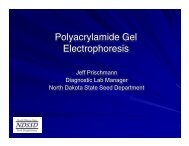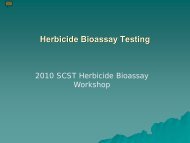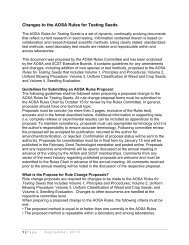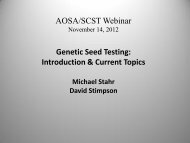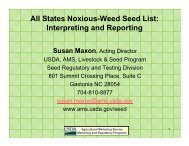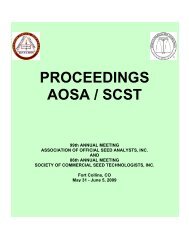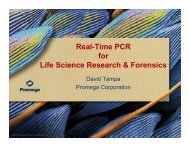Testing Overview, Mixing Herbicides
Testing Overview, Mixing Herbicides
Testing Overview, Mixing Herbicides
Create successful ePaper yourself
Turn your PDF publications into a flip-book with our unique Google optimized e-Paper software.
Introduction to Bioassay<br />
<strong>Testing</strong> and <strong>Mixing</strong><br />
Herbicide Solutions<br />
Michael Lovelace, Ph.D.<br />
Agronomist, USDA, AMS<br />
Seed Regulatory and<br />
<strong>Testing</strong> Branch<br />
Gastonia, NC<br />
http://www.ams.usda.gov/seed<br />
Agricultural Marketing Service<br />
Marketing and Regulatory Programs
FSA Requirements for<br />
Labeling Biotech-<br />
Derived Seed<br />
• No Federal Requirements<br />
• Section 201.8 of FSA Regulations<br />
– The label may contain information in<br />
addition to that required by the Act,<br />
provided such information is not<br />
misleading.<br />
Agricultural Marketing Service<br />
Marketing and Regulatory Programs
Biotech-Derived Varieties<br />
• After release, treated the<br />
same as traditional varieties<br />
under the labeling covered by<br />
the FSA.<br />
• FDA – non-toxic, non-allergenic<br />
• EPA – no threat to the<br />
environment<br />
• APHIS – completed the prerelease<br />
program<br />
Agricultural Marketing Service<br />
Marketing and Regulatory Programs
Common Methods for<br />
Detecting the Presence<br />
of Biotech-Derived Seed<br />
• DNA<br />
• Protein (Immunoassay)<br />
• Bioassay testing<br />
Agricultural Marketing Service<br />
Marketing and Regulatory Programs
What is Bioassay <strong>Testing</strong>?<br />
• Bioassay: appraisal of the biological activity<br />
of a substance by testing its effect on an<br />
organism and comparing the result with<br />
some agreed standard.<br />
• Substance: Herbicide (Roundup).<br />
• Organism: Crop sample of interest.<br />
• Agreed Standard: Check sample /<br />
Known resistant and<br />
susceptible seed samples.<br />
Agricultural Marketing Service<br />
Marketing and Regulatory Programs
Detecting Biotech-Derived<br />
Traits Using Bioassay <strong>Testing</strong><br />
• Bioassay testing of biotech derived seeds.<br />
– Seed soak test<br />
– Towel soak test<br />
– Spray test<br />
• Provides quantifiable<br />
data which can be<br />
subjected to tolerances.<br />
Agricultural Marketing Service<br />
Marketing and Regulatory Programs
Bioassay Test Determination<br />
• It is important to determine the test that<br />
best fits your needs.<br />
• Time restraints<br />
• Clarity of test results<br />
• Seed soak / Kimpak tests work best for<br />
soybeans and corn.<br />
• Towel soak tests or spray tests work<br />
best for cotton.<br />
Agricultural Marketing Service<br />
Marketing and Regulatory Programs
Bioassay Setup<br />
• Acquire sample seeds from purity<br />
test and count out the number of<br />
seeds needed to conduct the test.<br />
– Sample in question<br />
• Roundup Treatment<br />
• Water Check<br />
– Know susceptible sample<br />
• Roundup Treatment<br />
• Water Check<br />
– Known resistant sample<br />
• Roundup Treatment<br />
• Water Check<br />
Agricultural Marketing Service<br />
Marketing and Regulatory Programs
Prepare Working Solution<br />
• A working solution is the herbicide<br />
mixture used for seed soaking or<br />
wetting the towels.<br />
• Determine the concentration of the<br />
working solution from the test<br />
directions and gather information from<br />
pesticide label.<br />
Agricultural Marketing Service<br />
Marketing and Regulatory Programs
Preparation of Herbicide<br />
Working Solutions<br />
Prepare calculations for<br />
your herbicide working<br />
solution.<br />
Calculate concentration in<br />
PPM (Parts Per Million).<br />
or<br />
Calculate concentration in<br />
molarity (g / L).<br />
Agricultural Marketing Service<br />
Marketing and Regulatory Programs
Short Quiz<br />
• What is a PPM?<br />
• How do you calculate PPM?<br />
• What are the units of PPM?<br />
• Why is PPM unit-less?<br />
Agricultural Marketing Service<br />
Marketing and Regulatory Programs
Gathering Pertinent Information<br />
• Locate the area on the<br />
container that contains the<br />
pertinent information<br />
• Identify the active ingredients<br />
and corresponding<br />
concentrations.<br />
• Know what information is<br />
useful.<br />
Agricultural Marketing Service<br />
Marketing and Regulatory Programs
How much glyphosate is in 1<br />
Liter of Roundup?<br />
• Container indicates 50.2%<br />
glyphosate.<br />
• 50% of 1 liter is 500 ml, thus<br />
there are 500 ml of<br />
glyphosate in 1 L.<br />
• The container indicates there<br />
are 600 ml of glyphosate in 1<br />
L.<br />
• Where did we go wrong?<br />
Agricultural Marketing Service<br />
Marketing and Regulatory Programs
Why Not Calculate<br />
Based on Percentages?<br />
• Existing bioassay methods<br />
indicate concentration<br />
calculations should be<br />
based on percentage.<br />
• This can lead to problems<br />
because the label usually<br />
does not specify if<br />
percentages are based on<br />
weight or volume.<br />
• Why does it matter?<br />
Agricultural Marketing Service<br />
Marketing and Regulatory Programs
Importance of Percentage Type<br />
50% V / V (volumetric)<br />
1.4 g / cm 3 volume<br />
1.4 g / cm 3 weight<br />
50% g / g (gravimetric)<br />
Solvent<br />
If the<br />
solution is<br />
mixed on a<br />
Solvent<br />
If the<br />
solution is<br />
mixed on a<br />
basis,<br />
there will<br />
be about<br />
basis,<br />
there will<br />
be about<br />
glyphosate 10% more<br />
glyphosate 10% more<br />
1.7 g / cm 3 glyphosate<br />
1.7 g / cm 3 solvent on<br />
on a weight<br />
a volume<br />
basis.<br />
basis.<br />
If we assume that the percentage of glyphosate is 50% by volume<br />
and glyphosate is actually 50% by weight, we would be adding 10%<br />
less roundup to our working solution than we would anticipate.
Why Not Calculate<br />
Based on Percentages?<br />
• So, is it volumetric or<br />
gravimetric??<br />
• We don’t always know!!<br />
• Instead, use g ai / Liter<br />
or lb ai / gal<br />
Agricultural Marketing Service<br />
Marketing and Regulatory Programs
Calculating Working Solutions<br />
Determine the concentration of<br />
your working solution and how<br />
much you will need for the<br />
experiment.<br />
Examine herbicide container to<br />
establish concentration of stock<br />
solution.<br />
1000 PPM;<br />
1 Liter<br />
600 g / Liter<br />
Calculate the dilution of your<br />
stock solution to make your<br />
desired working solution.<br />
???<br />
Agricultural Marketing Service<br />
Marketing and Regulatory Programs
Calculating Working Solutions in PPM<br />
1,000 parts<br />
999,000 parts<br />
1 part<br />
999 parts<br />
1 g<br />
999 g<br />
= =<br />
=<br />
1 ml<br />
999 ml<br />
Roundup Ultra Max = 600 g ai<br />
1000 ml<br />
Must dilute roundup to acquire<br />
desired concentration.<br />
600 g ai<br />
1000 ml<br />
= 1 g ai<br />
X<br />
cross multiply<br />
X =<br />
1 g ai X 1000 ml<br />
600 g ai<br />
X = 1.67 ml<br />
Water<br />
1 ml = 1 g (assumption)<br />
Add the 1.67 ml of herbicide solution to 998.33 ml of water to make a<br />
1000 PPM working solution.<br />
Are we done?? Not so fast!! There is still more to consider!!<br />
Agricultural Marketing Service<br />
Marketing and Regulatory Programs
Calculating Working Solutions in PPM<br />
• Lets revisit the label.<br />
• The label indicates glyphosate is in<br />
the form of isopropylamine salt.<br />
• Why is this important?<br />
• The isopropylamine salt portion of<br />
the formulation has no herbicidal<br />
activity. Furthermore, different<br />
formulations of glyphosate have<br />
different salts.<br />
• In order to avoid any confusion,<br />
our calculations need reflect the<br />
amount of glyphosate free acid<br />
(portion without the salt) in the<br />
solution.
Formulation Comparisons<br />
O<br />
O<br />
HO<br />
N<br />
P<br />
O -<br />
+ H3 N<br />
Glyphosate Free Acid (169 g / mole)<br />
Isopropylamine Salt (59 g / mole)<br />
• Glyphosate free acid = 169 g / mole<br />
• IPA salt of glyphosate = 228 g / mole<br />
• DAM salt of glyphosate = 201 g / mole<br />
• TMS salt of glyphosate = 244 g / mole<br />
Agricultural Marketing Service<br />
Marketing and Regulatory Programs
Calculating Working Solutions in PPM<br />
1,000 parts<br />
999,000 parts<br />
1 part<br />
999 parts<br />
1 g<br />
999 g<br />
= =<br />
=<br />
1 ml<br />
999 ml<br />
Roundup = 600 g IPA salt of glyphosate<br />
Ultra Max 1000 ml herbicide solution<br />
Roundup = 0.445 g glyphosate free acid<br />
Ultra Max ml herbicide solution<br />
X<br />
169 g glyphosate free acid<br />
228 g IPA salt of glyphosate<br />
0.445 g ai<br />
1 ml herb = 1 g ai<br />
X<br />
cross multiply<br />
X =<br />
1 g ai X 1 ml<br />
0.445 g ai<br />
X = 2.25 ml herb<br />
Water<br />
1 ml = 1 g<br />
Herb solution<br />
1 ml ≠ 1 g<br />
Due to the different densities of water and herbicide solution, it may not<br />
be appropriate to add 2.25 ml of herbicide solution to 997.75 ml of water.<br />
Instead, it would be more appropriate to tare a beaker on a balance. Add<br />
about half the quantity of water desired. Add your herbicide solution.<br />
Add water to the beaker until the scale reads 1000 grams.
Use of Molarity<br />
• Use g ai / Liter or lb ai / gal<br />
• Use molecular weight (169.07)<br />
of the glyphosate molecule.<br />
• Percentage, density of<br />
solution, and makeup of inert<br />
ingredients is irrelevant in<br />
calculation.<br />
• Calculations are accepted SI<br />
units, whereas PPM is not.<br />
Agricultural Marketing Service<br />
Marketing and Regulatory Programs
Calculation Conclusions<br />
• Things are not always as<br />
easy as they seem.<br />
• We need to rethink the way<br />
we do our calculations.<br />
• A common worksheet may<br />
standardize our herbicide<br />
solutions.<br />
• Molarity is a great alternative<br />
because there is no<br />
confusion with units.<br />
Agricultural Marketing Service<br />
Marketing and Regulatory Programs
Interpreting Results<br />
• Count the number of seedlings in the treated<br />
sample and water check.<br />
– Normal seedlings.<br />
– Note differences between abnormals and seedlings<br />
appearing susceptible to glyphosate (may use test<br />
strips for clarification).<br />
– Ungerminated seeds.<br />
• Interpret results<br />
– Test analysis only on germinated seeds.<br />
– Differentiate between abnormals and seedlings<br />
appearing treated with glyphosate(may use test<br />
strips for clarification).<br />
• Apply results to tolerance tables.
Example Results<br />
• Test 1<br />
• 100 seed test on<br />
pure seed<br />
• Label – 98% pure<br />
seed<br />
• Test results – 4<br />
biotech-derived<br />
seedlings (4%).<br />
• Test 2<br />
• 400 seed test on<br />
pure seed<br />
• Label – 98% pure<br />
seed<br />
• Test results – 16<br />
biotech derived<br />
seedlings (4%)<br />
Agricultural Marketing Service<br />
Marketing and Regulatory Programs
Purity Tolerance Table<br />
Seed,<br />
Seedling, or<br />
Plant Count<br />
Present<br />
Number of seeds, seedlings, or plants in tests<br />
30 50 75 100 150 200 400 800 1000<br />
100 or 0 0 0 0 0 0 0 0 0 0<br />
98 or 2 6.0 4.6 3.8 3.3 2.7 2.3 1.6 1.2 1.0<br />
96 or 4 8.3 6.4 5.3 4.6 3.7 3.2 2.3 1.7 1.5<br />
94 or 6 10.1 7.8 6.4 5.5 4.5 3.9 2.9 2.1 1.9<br />
92 or 8 11.5 8.9 7.3 6.3 5.2 4.5 3.4 2.4 2.2<br />
96 + 4.6 = 100.6 96 + 2.3 = 98.3<br />
90 or 10 12.8 9.9 8.1 7.0 5.7 4.9 3.8 2.8 2.4<br />
88 or 12 13.8 10.7 8.7 7.6 6.2 5.4 4.1 3.0 2.7<br />
86 or 14 14.7 11.4 9.3 8.1 6.6 5.7 4.5 3.2 2.9<br />
Sec 201.62. Tests for determination of percentages of kind, variety, type, hybrid, or off-type.– Tolerances for tests for determination of percentages of<br />
kind, variety, type, hybrid, or off-type shall be those set forth in this table, added to ½ the required pure seed tolerances determined in accordance with<br />
section 201.60, except that ½ the pure seed tolerance will not be applied in determining tolerances for hybrids labeled on the basis of percentage of<br />
pure seed which is hybrid<br />
Agricultural Marketing Service<br />
Marketing and Regulatory Programs
Interpretation of Results<br />
• Test 1<br />
• In tolerance.<br />
• No violation of<br />
FSA.<br />
• Action – none.<br />
• Test 2<br />
• Out of tolerance.<br />
• Violation of FSA.<br />
• Possible re-test.<br />
• Action – begin<br />
investigation of<br />
shipment.<br />
Agricultural Marketing Service<br />
Marketing and Regulatory Programs
Conclusions<br />
• Tolerances are applied to all seed, including<br />
biotech derived seed.<br />
• Presence of biotech derived seeds in a seed<br />
lot does not put it out of tolerance.<br />
• Currently in the U.S., the presence of biotech<br />
derived seeds in conventional seed lots does<br />
not warrant any special labeling.
Questions or Comments



